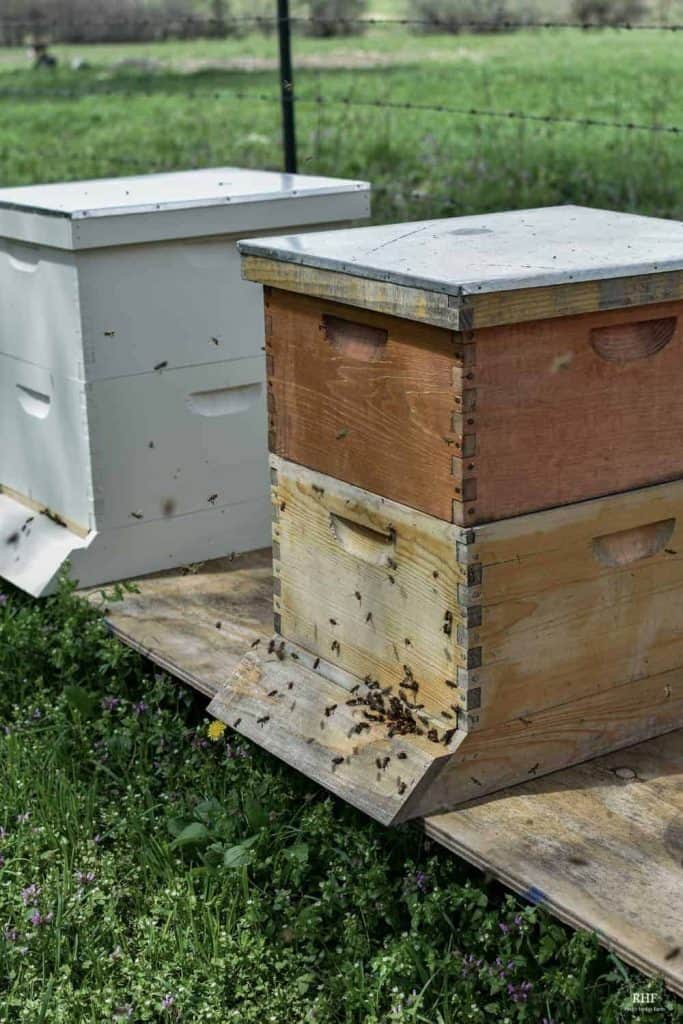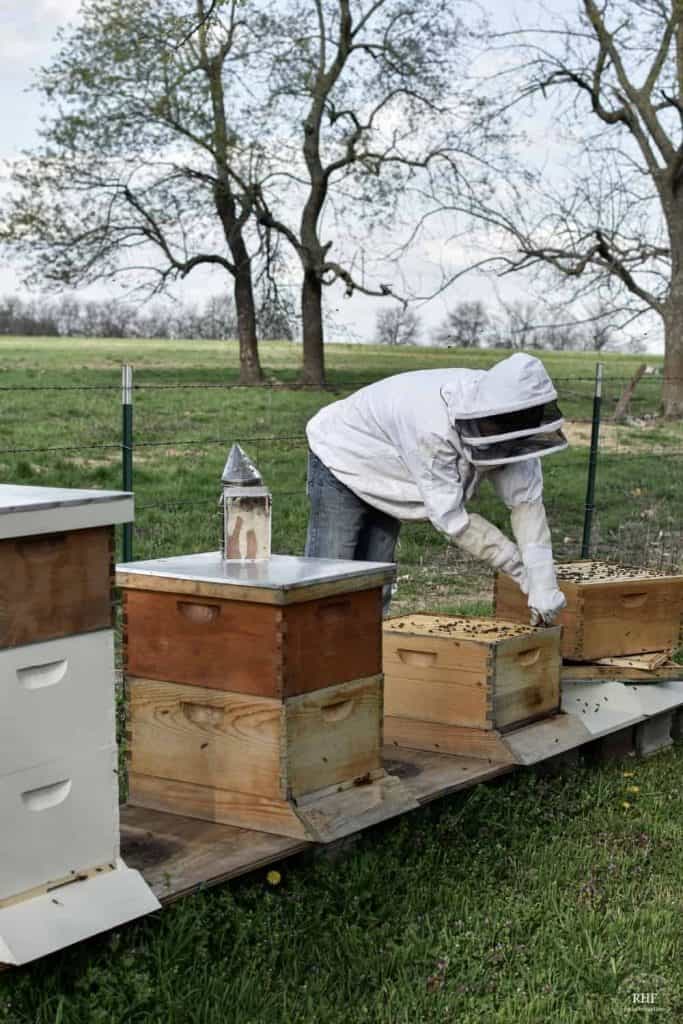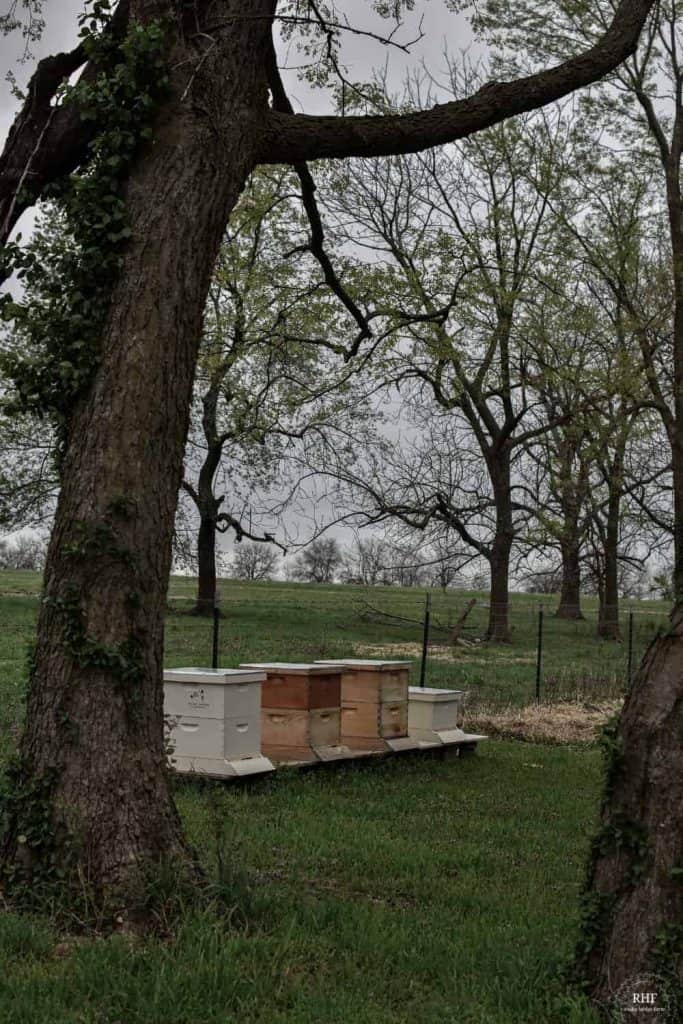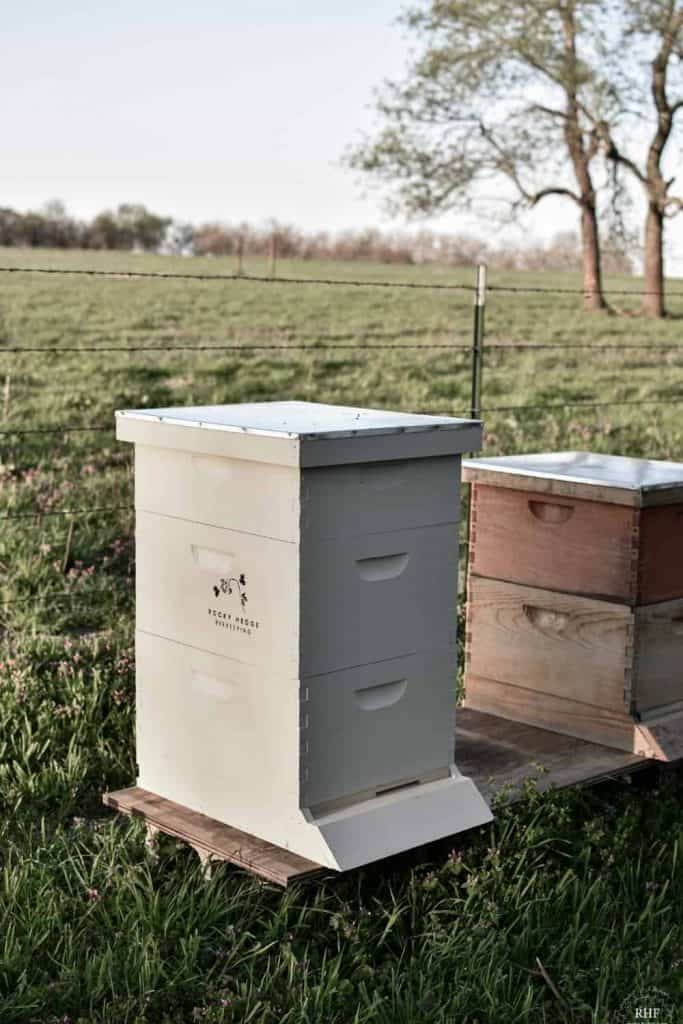Parts of a Langstroth Beehive Structure
For a basic hive, the parts of a Langstroth beehive structure include a hive stand, bottom board, entrance reducer, hive body, honey super, foundation, frames, inner cover, and an outer hive cover.
If beekeeping is one of those things, you have always wanted to do, start by reading the first post in this series, Backyard Beekeeping for Beginners. Keeping honey bees requires planning, knowledge, and an investment of time and money. Understanding the parts of a Langstroth beehive structure is the next post of this ongoing beekeeping series.

Table of contents

Beehive Structure Design
Before bees arrive, it must be determined where they will live. The two most popular, basic types of beehives include Langstroth Hive and Top Bar Hive. Less common options are the Warre Hive and Flow Hive.
With easy-to-find information and readily available supplies, the most common type of hive, the Langstroth beehive, is the best design for a beginner.
In 1851, Lorenzo Langstroth, a minister and beekeeping hobbyist from Massachusetts, invented the hive. The first hive was to have removable frames that allowed beekeepers easy access for hive inspections.

Langstroth Hive
The Langstroth is the most iconic of beehive designs and is the most common beehive seen in North America. This post will deal with the American version of the standard ten-frame Langstroth hive.
Langstroth hives are made by stacking rectangular boxes with removable frames for the bees to build comb. Having removable frames allows beekeepers to cause less disturbance to the bees and to do beehive inspections without destroying the honeycomb structure.
Langstroth hive configuration allows the beekeeper to stack boxes of various heights. Langstroth hive typically consists of a hive stand, bottom board, entrance reducer, two hive bodies (known as deep supers for brood), one or two supers (known as mediums supers for surplus honey), an inner cover, and an outer hive cover. There are two widths, including the 8 frame or 10 frames.
The Langstroth hive can be considered to be made up of three different sections. The lower section, boxes, and the upper section.
- Lower Section: The lower section includes the base on which the box sits and the bottom board. This is the entrance in which the bees enter the hive and leave.
- Boxes: Inside the box is where the brood, honey, pollen, propolis, and bees are housed. The great feature about the Langstroth is expanding by adding boxes to support the colony’s growth.
- Upper section: The hive’s top includes the inner cover, which sits on the top box, plus a top cover to protect the entire structure.

Advantages of a Langstroth Beehive
- Easy Harvesting: Langstroth hives are easy to harvest honey from as the beekeeper can remove the desired frames.
- Movable: Hives are easily moved as the components can be disassembled and then restacked in another location.
- Production: Honey super boxes can continue to be added, providing greater honey yield potential.
- Standard Equipment: Components in the hive come in a standard shape and size with a wide range of suppliers and equipment. Consistency in size makes boxes easily interchangeable and is most likely the preferred hive among beekeepers.
Disadvantages of a Langstoth Hive
- Weight: Filled with bees and honey, a deep hive box can weigh 60-90 pounds. A medium honey super can weigh around 50 pounds.
- Storage Space: When boxes are not needed for expanded the colony or being used for honey production during the winter, the equipment needs to be stored.

Parts of a Langstroth Beehive Structure
Hive Stand
The hive stand is the base support. It serves to keep the bottom board off the ground, keeps the hive stable, discourages ants and skunks. It also makes hive inspections easier with less bending and lifting.
Bottom Board
The bottom board of a beehive is the colony floor and the structure that supports the hive’s full weight. Hives should not be placed directly on the ground but instead at least 18″ off the ground on a hive stand.
A bottom board consists of two side rails with a woodblock across the back. A gap is located at the front to provide an entrance and an exit for the bees.
There are two different styles when purchasing bottom boards, including ones with a solid bottom floor or a screened floor. There is some evidence that screened floors increase brood production and reduce varroa mites’ growth rate.
In hot summer climates, the screened bottom allows for better hive ventilation. This helps the bees not to have to work as hard to keep the hive cool. In areas that experience cold winter climates, solid wood bottoms help keep the hive warmer and improve winter moisture levels.
Entrance Reducer
An entrance reducer is a small piece of wood that creates a barrier at the beehive entrance that reduces the opening’s size where the bees enter and exit. Usually made of wood, they have a choice of two beehive entrance hole sizes, one small and one large, so that you can make adjustments through the year.
The purpose of using entrance reducers is to protect a hive from robbing honey bees or weak hives just starting. A small opening gives the bees a better defense against guarding their hive. Another reason to use an entrance reducer is to protect the hive from cold drafts, keep snow from entering, and prevent mice from entering the hive during the winter months.
Hive Body
Sometimes called a deep super, brood box, or a deep, the hive body is a wooden box that serves as the living quarters for the colony. It is placed directly on top of the bottom board, and the hive body is the tallest part of a Langstroth beehive structure. The heart of the colony, the hive body’s deep size, provides egg-laying space for the queen. One hive body provides enough space for 50,000 – 60,000 worker bees.
Depending on climate conditions, the hive body may use one or two deep boxes. It is advised to use two deeps in colder regions to provide enough honey storage space for the bees during the winter.
Inside a deep box is where the bees raise the young and store food for themselves. The honey in these boxes is strictly for the bees and not to be harvested for the beekeeper.
Queen Excluder
An optional device, this metal grid allows the worker bees to pass freely between the boxes, but the larger queen can not. The queen excluder is placed between the deep (brood) box and the honey supers.
The sole purpose of the queen excluder is to restrict the queen from laying eggs in the honey supers. The queen will continue to lay eggs in the hive body while the workers fill the honey supers’ frames with honey.
A queen excluder is usually not necessary in hives with more than one hive body. In nature, a honey bee nest has a central core of brood on the bottom with honey stores above.
In a two hive body Langstroth beehive structure, the honey barrier occurs in the second hive body. Generally, a queen will not cross this honey barrier and lay eggs above it.
Honey Supers or Shallow Supers
A honey super is the top box part of a Langstroth beehive structure. The purpose of the honey super, also known as the medium super or shallow super, is to provide storage space for honey that the beekeeper harvests. Supers are placed above the brood boxes (hive body).
Available in two different depths, it is recommended to use a medium or shallow box for honey storage. The medium super is the most common among beekeepers; they are smaller than hive bodies which keeps them lighter and easier to lift when full of honey. As honey flow increases, honey supers can continue to be stacked on top of the hive.
Foundation
Some sort of foundation is necessary for every frame. Foundation is where a colony’s life functions happen, from laying eggs, raising young, storing pollen and honey.
Foundation is a sheet of beeswax or plastic with hexagonal cells’ shape on a flat layer fitting into the frame’s rectangular shape. Bees naturally prefer to use the foundation with beeswax instead of plastic. While plastic is more durable, the bees can be slower to draw it out.
When choosing a foundation, whether natural beeswax or plastic, pick one type of foundation and use it for the entire hive.
The foundation aims to encourage bees to build a straight comb down the frame’s length. Without foundation, the bees will often move between frames, making it near impossible to remove frames during hive inspections without causing damage to the natural foundation.
Frames
Standard hive bodies and supers are made to accommodate ten frames. Without a frame, a natural comb would bend and break when handled. There are many different frame options and methods for construction. A frame consists of four parts: a top bar, two end bars, and a bottom bar. A traditional top bar comes with a removable wooden wedge that is removed and then re-nailed to hold the foundation in place.
Inner Cover
The inner cover is a wooden cover placed on top of the uppermost box. The inner cover helps maintain bee space and allows moisture to escape and fresh air circulated throughout the hive. It also helps prevent bees from propolizing the outer cover, making it very difficult to open.
Should the beehive inner cover notch go up or down? During winter, turn the notched side of the inner cover down. In the summer, turn the notched side up.
Outer Beehive Cover
Outer beehive covers are the roof over the hive. The purpose of the outer beehive cover is obvious; just like you want a good roof over your home, the bees need one as well to protect them from the elements.

Where to Purchase the Parts of a Langstroth Beehive Structure
The basic parts of a Langstroth beehive structure include a hive stand, bottom board, entrance reducer, hive body, honey super, foundation, frames, inner cover, and an outer hive cover. It is always good to keep extra supplies on hand in case hive swarms. Here is a list of needed items to build a basic hive.
- Outer Hive Cover
- Inner Cover
- Frames with Foundation
- Honey Supers
- Queen Excluder
- Hive Body
- Entrance Reducer
- Bottom Board
- Hive Stand

Frequently Asked Questions
What Are The Parts of a Beehive Called
For a basic hive, the parts of a Langstroth beehive structure include a hive stand, bottom board, entrance reducer, hive body, honey super, foundation, frames, inner cover, and an outer hive cover.
How Many Boxes Does a Hive Have?
The general answer is that one or two brood boxes are sufficient per hive. Using a single brood box with a super can be done; once bees start running out of space, add another super. Start with one brood box, and then as needed, add another brood box.
Another option, start with one brood box, and when bees are running out of space, add another brood box. Once that brood box is full, begin adding supers.
How Many Brood Boxes Should a Hive Have?
Generally, two brood boxes at most. Using more than two brood boxes can cause stress for a colony. If you feel that more than two brood boxes are needed, it is best to split the colony.
What Are Supers in a Bee Hive
Supers are the boxes placed on a beehive for bees to store honey. Supers are where the bees will place honey that you can take off the hive to harvest.
How Many Supers Can You Put on a Hive?
It is nearly impossible to put a specific number on how many supers can be added to a hive. The honey flow will vary from year to year and vary by the hive region. The general idea is to add enough supers for the honey flow. In a good honey flow season, a strong hive can fill a super in one to two weeks.
How High Should Beehives be Off the Ground?
How high a hive should be off the ground will vary between beekeepers. Generally, it is recommended to have hives at least 18″ off the ground. This height is ideal for working the hives and preventing pests and predators while keeping the hive dry with a clear entrance.






